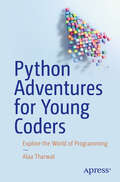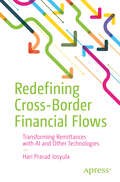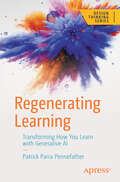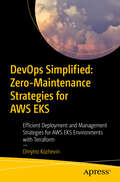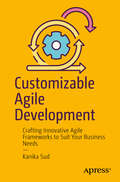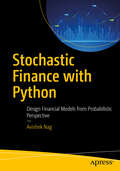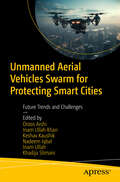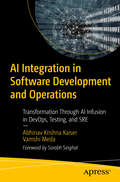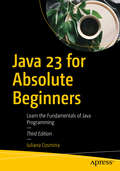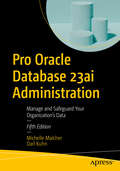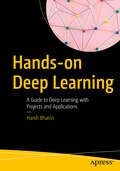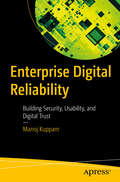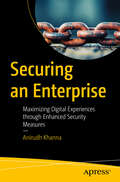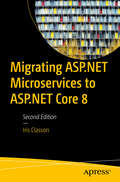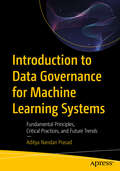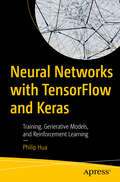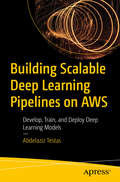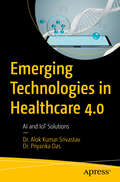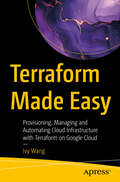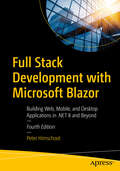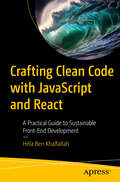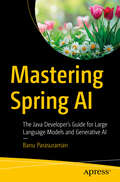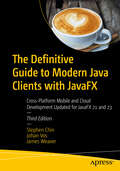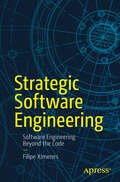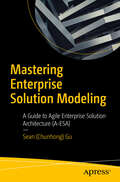- Table View
- List View
Python Adventures for Young Coders: Explore the World of Programming
by Alaa TharwatThis book takes young readers on an exciting adventure with a child named Kai. One day, Kai wakes up trapped inside a giant robot. He can't talk to anyone outside, and the only way to communicate is through the robot. Inside the robot, Kai finds many books and documents written in a strange language—it's the robot's language, which is Python. Kai realizes he needs to learn this language to control the robot and talk to the outside world. In each chapter in this book, we will join Kai on a new adventure to learn something that helps us control the robot better and communicate with the real world. This fun and interactive book is designed to introduce young minds to the basics of programming while encouraging creativity and problem-solving skills. In the introductory chapters, readers discover Python as a friendly and accessible programming language. The book guides them through setting up their programming environment and crafting their initial lines of code, laying the foundation for an exciting coding adventure. As the exploration unfolds, it delves into fundamental programming concepts essential for any budding coder. From variables and data types to loops and conditionals, these building blocks empower readers to create their programs, fostering a solid understanding of the core principles of coding. It seamlessly integrates these concepts with previously learned fundamentals, providing a comprehensive view of Python's capabilities. Fueling creativity, it inspires readers to unleash their imagination through engaging projects. From crafting games to developing useful applications, young coders learn to apply their programming skills in innovative ways, transforming abstract coding concepts into real and interactive projects. With a focus on accessibility, engagement, and real-world application, this book paves the way for the next generation of Python enthusiasts. What you will learn: Understand Python programming fundamentals, including syntax, variables, data types, loops, conditionals, lists, functions, and handling files. Learn to break down complex problems into smaller, manageable tasks and apply coding concepts to find creative solutions. How to create their interactive coding projects using Python. Understand strategies for debugging and troubleshooting common programming problems, which are essential skills for any programmer Who this book is for: This book caters primarily for high school students and individuals keen on delving into programming with minimal or zero coding background. It's structured to be both accessible and captivating for young readers, immersing them in the realm of coding through entertaining and interactive journeys. Moreover, it extends its reach to educators and coding enthusiasts alike.
Redefining Cross-Border Financial Flows: Transforming Remittances with AI and Other Technologies
by Hari Prasad JosyulaAnalyse how AI and other cutting-edge technologies affect the complex web of international financial transactions. The global remittance sector and artificial intelligence (AI) work together in a way that is testament to the revolutionary force of innovation in the always changing financial and technology landscape. As we stand at the threshold of a new age, this book aims to explore the layers of complexity underlying the confluence of AI and remittances. Your investigation will go beyond the current state of affairs and into the future, whereby predictive analytics and autonomous financial transactions will fundamentally alter the way that we send and receive money internationally. This process's incorporation of AI technology represents a revolution rather than a simple progression, one that might improve millions of people's lives by streamlining, securing, and lowering the cost of financial transactions. This book breaks down the complex workings of AI prediction models, reveals how blockchain integration may be used to facilitate safe and transparent transactions, and examines how biometric authentication can strengthen the security of financial transactions. It dives into the complexities of regulatory compliance, understanding the difficult balance between innovation and conformity to existing standards. When machines carry out transactions based on complex algorithms and current market circumstances, what does it entail for people and economies? What effect does this change have on how people make financial decisions? This book is an invitation to imagine a future in which financial systems are not just efficient but also naturally intelligent. It is a call to reflect on the moral ramifications, the effects on society, and the obligations that accompany the dawn of a new era of financial opportunity. Remittances are about to undergo a revolution, and you have a crucial role to play in determining how this will play out. What You’ll Learn Understand the integration of AI and other technology in remittances to enhance efficiency, security, and cost-effectiveness of cross-border financial transactions. Examine the impact of AI-driven cross border flows on global economic development, particularly in communities heavily reliant on remittances. Investigate the social benefits and potential challenges posed by AI in maintaining or altering familial and community ties through remittance flows Critically evaluate regulatory and ethical challenges while fostering innovation and adhering to existing financial laws and standards. Explore future scenarios where AI governs autonomous financial transactions and the role of humans in an AI-driven financial ecosystem. Debate how such changes might redefine personal and communal financial interactions. Who This Book Is For FinTech practitioners, Finance students, professionals in working in Payments and/or Remittances
Regenerating Learning: Transforming How You Learn with Generative AI (Design Thinking)
by Patrick Parra PennefatherThe perfect storm of learning provoked by generative AI is not just about learning how to use the technology to change human patterns of work and life. The technologies are re-orienting how we think we learn, what we learn, what we need to learn, when and where we learn about knowledge production, how humans communicate with each other, the economic, social, political, creative, ethical and technological factors that inform how we navigate human influenced existence on this planet. The technology empowers you to reimagine and reinvent how you learn while doing your work. Just like you can regenerate content persistently using generative AI systems, so too can you regenerate what and how you learn. Regenerating Learning will help guide the small team you are a part of, or influence leadership to leverage generative AI systems responsibly. Besides pointing to all the more obvious benefits of learning how to use generative AI systems more effectively, this book provides use cases, research and educational theory to propose that interacting with the technology leads to a number of unanticipated learning outcomes. These outcomes challenge the very way in which we have come to learn, what we have learned, and what we may need to unlearn. As generative AI becomes increasingly integrated within workplace environments at some point or other we will each need to decide if we are going to use the technology and how. What You will Learn • Methods and techniques to re-learn how you learn through your interactions with different generative AI. • Strategic approaches to integrate generative AI within your workflows. • How to iterate, adapt, prototype and learn continuously with generative AI. • A variety of tools and approaches to reconcile your organization’s use of generative AI. • How to develop a road map towards the integration of AI systems within your organization. Who this Book Is For Creatives, team leaders, managers and leadership in different organizations; teams in collaborative and creative industries; managers and employees in organizational learning
DevOps Simplified: Efficient Deployment and Management Strategies for AWS EKS Environments with Terraform
by Dmytro KozhevinGain the knowledge and practical skills needed to deploy a fully functional, secure, and scalable application in AWS EKS. This book is a hands-on guide designed to help you navigate and manage infrastructure in the AWS EKS environment. The book starts by reviewing the concept of DevOps flexibility, emphasizing adaptability to manage changes effectively. It covers foundational elements like IAM basics, user management, and the use of Terraform for infrastructure as code, highlighting the importance of version stability and unique CIDR blocks. Moving forward, you’ll explore Kubernetes, and its initial set-up steps, such as configuration management, access control, and storage. You’ll also see how to bridge Kubernetes with AWS resources, touching upon service accounts, identity federation, and policy assignment. In the final chapters, the book guides you through the complete setup of a fully working application using Terraform. The book culminates with a step-by-step walkthrough of deploying a complete application environment where you’ll generate and distribute access credentials, configure persistent storage, and manage RBAC for users, all using Terraform. Zero-Maintenance Strategies for AWS EKS will provide you with a solid foundation and a toolkit of proven strategies for managing cloud infrastructure. What You Will Learn Understand the concept of DevOps flexibility and its practical applications Acquire foundational knowledge in IAM basics and user management. Manage external access to your applications while consolidating load balancing through a single, entry point. Securely configure DNS and SSL, ensuring your application is both accessible and protected. Who This Book Is For DevOps professionals, IT managers, and software developers who are looking to adopt or improve their DevOps practices, and students and educators in IT-related fields.
Customizable Agile Development: Crafting Innovative Agile Frameworks to Suit Your Business Needs
by Kanika SudThe one-size-fits-all approach to Agile project management doesn't always fit an organization's needs. This book seeks to highlight the importance of experimentation and customization in modern project management practices. In an era of digital transformation and rapid disruption, organizations must continuously strive to innovate and tailor their methodologies in order to thrive. You'll start by looking at key fundamentals and challenges, setting an agile mindset to then explore the basics of Agile, Scrum, Kanban, and Lean. Aided by practical examples and real-world case studies. you'll then move onto the more practical part of the book and can create customizable Agile frameworks using innovative practices and hybrid models to suit individual needs. With Customizable Agile Development as your guide, you'll be confident in how to adapt and create agile methodologies and frameworks that truly fit your requirements and needs. What You Will Learn Adapt Agile practices to their specific industry and context. Foster a culture of experimentation and continuous improvement. Create Agile frameworks that optimize efficiency and value delivery. Harness Agile methodologies to stay ahead in a rapidly changing world. Who This Book Is For Agile coaches and practitioners as well as product managers and strategy advisors
Stochastic Finance with Python: Design Financial Models from Probabilistic Perspective
by Avishek NagJourney through the world of stochastic finance from learning theory, underlying models, and derivations of financial models (stocks, options, portfolios) to the almost production-ready Python components under cover of stochastic finance. This book will show you the techniques to estimate potential financial outcomes using stochastic processes implemented with Python. The book starts by reviewing financial concepts, such as analyzing different asset types like stocks, options, and portfolios. It then delves into the crux of stochastic finance, providing a glimpse into the probabilistic nature of financial markets. You’ll look closely at probability theory, random variables, Monte Carlo simulation, and stochastic processes to cover the prerequisites from the applied perspective. Then explore random walks and Brownian motion, essential in understanding financial market dynamics. You’ll get a glimpse of two vital modelling tools used throughout the book - stochastic calculus and stochastic differential equations (SDE). Advanced topics like modeling jump processes and estimating their parameters by Fourier-transform-based density recovery methods can be intriguing to those interested in full-numerical solutions of probability models. Moving forward, the book covers options, including the famous Black-Scholes model, dissecting it from both risk-neutral probability and PDE perspectives. A chapter at the end also covers the discovery of portfolio theory, beginning with mean-variance analysis and advancing to portfolio simulation and the efficient frontier. What You Will Learn Understand applied probability and statistics with finance Design forecasting models of the stock price with the stochastic process, Monte-Carlo simulation. Option price estimation with both risk-neutral probabilistic and PDE-driven approach. Use Object-oriented Python to design financial models with reusability. Who This Book Is For Data scientists, quantitative researchers and practitioners, software engineers and AI architects interested in quantitative finance
Unmanned Aerial Vehicles Swarm for Protecting Smart Cities: Future Trends and Challenges
by Keshav Kaushik Inam Ullah Khan Inam Ullah Oroos Arshi Nadeem Iqbal Khadija SlimaniExplore the intersection between unmanned aerial vehicles (UAVs) and the evolving landscape of smart cities. With the increasing integration of technology into urban environments, there is a growing need to understand how UAV swarms can contribute to the safety, efficiency, and resilience of these complex urban ecosystems. The book aims to provide a technical understanding of UAV swarms and their applications within the context of smart cities. It begins by laying the groundwork with an introduction to UAV swarms and smart cities, establishing the foundational concepts and motivations behind their integration. As the book progresses, it delves into various aspects of smart cities, exploring concepts, technologies, and challenges inherent in their development and operation. This includes discussions on cloud computing, cybersecurity, machine learning applications, surveillance and monitoring systems, urban planning, and infrastructure management. It also examines the integration of IoT devices with UAV swarms, highlighting the synergies between these emerging technologies and their potential impact on urban environments. The book examines cutting-edge topics such as edge computing, blockchain applications, 5G integration, and augmented reality/virtual reality (AR/VR) visualization techniques in the context of UAV swarm operations. It concludes with reflections on innovations and future directions, offering insights into the evolving landscape of UAV swarm technologies and their implications for the protection and advancement of smart cities. The book serves as a comprehensive guide for researchers, practitioners, and policymakers interested in understanding the technical, social, and economic dimensions of UAV swarm technology within the context of smart city development and management. What You Will Learn Identify practical applications of UAV swarms in surveillance monitoring, urban planning, disaster management, and infrastructure resilience Gain comprehensive understanding of UAV swarms by exploring diverse disciplines Apply insights from emerging technologies like cloud computing, machine learning, blockchain, IoT devices, and so on to UAV swarm technology Who Is This Book For This book appeals to a wide range of readers with different interests and backgrounds, including researchers, policymakers, industry stakeholders, practitioners, experts, and general fans who are curious in the confluence of smart cities with UAV swarm technologies with little to no experience or knowledge of UAV swarms.
AI Integration in Software Development and Operations: Transformation Through AI Infusion in DevOps, Testing, and SRE
by Abhinav Krishna Vamshidhar MedaDiscover how Artificial Intelligence (AI) is transforming the fields of software development, testing, and IT operations by enhancing efficiency, reducing human error, and accelerating processes. This book showcases the practical applications of AI-driven tools, such as automating coding, testing, and operational tasks, predicting potential issues, and optimizing performance. Aimed at digital leaders, practitioners, and customers, this book provides strategic insights and actionable guidance on how to integrate AI technologies to boost productivity, enhance product quality, and streamline development cycles. It serves as a comprehensive guide for those looking to leverage AI to drive innovation, cut costs, and stay competitive in an ever-evolving technological landscape. You’ll explore how AI can be integrated into software development, testing, and IT operations to improve efficiency, accuracy, and speed. Through real-world use cases, you’ll see how AI-driven tools can automate tasks, reduce human error, and improve processes across the development lifecycle. AI Integration in Software Development and Operations offers actionable insights on using AI to accelerate innovation, enhance product quality, and optimize costs in your modern software and IT environments. What You Will Learn Review the SDLC lifecycle, DevOps, SRE and accompanying topics Understand machine learning basics, AI techniques, and data preprocessing for DevOps Explore how AI integration into all phases of SDLC boosts productivity, increases effectiveness, and reduces human error Gain a familiarity with AI tools, their use cases, and the value in integrating them Who This Book is For Software engineers, developers, programmers, DevOps engineers, and AI practitioners who are interested in integrating AI into their DevOps practices.
Java 23 for Absolute Beginners: Learn the Fundamentals of Java Programming
by Iuliana CosminaWrite your first code in Java 23 using simple, step-by-step examples that model real-word objects and events, making learning easy. With this book you will be able to pick up core programming concepts without fuss and write efficient Java code in no time. Clear code descriptions and layout ensure you get your code running as soon as possible. Author Iuliana Cosmina focuses on practical knowledge and getting you up to speed quickly—all the bits and pieces a novice needs to get started programming in Java. In this edition, you will discover how Java has changed since version 17, and how to design and write code using the most recently introduced Java features such as new collection methods, virtual threads, pattern and record matching in switch expressions, structured concurrency tasks, unnamed classes and instance methods, and many more. This book is a complete Java guide, covering the following topics: setting up a development environment, programming concepts and well-known programming principles, writing Java code following industry-specific design patterns and coding conventions, executing it, debugging, testing, documenting it and even using specialized tools such as IntelliJ IDEA for writing Java code, Maven for building, JUnit Jupiter for testing, and in-memory and Docker-hosted databases or data storage. After reading this book, you’ll have all the necessary skills and knowledge to pass an interview for a starting Java development position. What You Will Learn Set up a Java development environment Use the Java language to write high-quality code Understand fundamental programming concepts and algorithms Use virtual threads, records, and other Java renown features Debug, test, and document Java code Improve performance by customizing the Garbage Collector Who This Book Is For Those who are new to programming and want to learn Java and use it to build efficient solutions
Pro Oracle Database 23ai Administration: Manage and Safeguard Your Organization’s Data
by Darl Kuhn Michelle MalcherMaster Oracle Database administration in both on-premises and cloud environments. This new edition covers the tasks you’ll need to perform to keep your databases tuned and performing, and includes new, important innovations with AI Vector Search, JSON Duality Views, and Select AI. Since Oracle Database 23ai offers a choice of platforms with on-premises and cloud, the book also includes administrative tasks specific to cloud environments, including the Oracle Autonomous Database running in the Oracle Cloud Infrastructure. New in this edition is help for DBAs who are becoming involved in data management, and a look at the idea of a converged database and what that means in handling various data types and workloads. The book covers some of the machine learning features now in Oracle and shows how the same SQL that you know for database administration also helps you with data management tasks. The information in this book helps you to apply the right solution at the right time, mitigating risk and making robust choices that protect your data and avoid midnight phone calls. Data management is increasingly a DBA function, and DBAs are often called upon for help in getting data loaded into analytics environments such as a data lakehouse or a data mesh. This book addresses this fast-growing new role for database administrators and helps you build on your existing knowledge to make the transition into a new skill set that is in high demand. You’ll learn how to look at data optimization from the standpoint of data analysis and machine learning so that you can be seen as a key player in preparing your organization’s data for those type of activities. You’ll know how to pull back information from a combination of relational tables and JSON structures. You’ll become familiar with the tools that Oracle Database provides to make analytics easier and more straightforward. And you’ll learn simpler ways to manage time-based tables that eliminate the need for painfully creating triggers to track the history of row changes over time. This book builds your skills as an Oracle Database administrator with the aim of helping you to be seen as a key player in data management as your organization pivots toward cloud computing and a greater use of machine learning and analytics technologies. What You Will Learn Configure and manage Oracle 23ai databases both on-premises and in the cloud Meet your DBA responsibilities in the Oracle Cloud and with Database Cloud Services Leverage converged database capabilities to manage different workloads, structured and unstructured data Perform administrative tasks for Autonomous Database dedicated environments Perform DBA tasks and effectively use data management tools Migrate from on-premises to the Oracle Cloud Infrastructure Troubleshoot issues with Oracle 23ai databases and quickly solve performance problems Architect cloud, on-premises, hybrid, and multi-cloud database environments Who This Book Is For Oracle database administrators (DBAs) who want to be current with the new features in Oracle Database 23ai. For any DBA who is tasked with managing Oracle databases in cloud, hybrid cloud, and multi-cloud configurations. Also helpful for data architects who are designing analytic solutions in data lake house and data mesh environments.
Hands-on Deep Learning: A Guide to Deep Learning with Projects and Applications
by Harsh BhasinThis book discusses deep learning, from its fundamental principles to its practical applications, with hands-on exercises and coding. It focuses on deep learning techniques and shows how to apply them across a wide range of practical scenarios. The book begins with an introduction to the core concepts of deep learning. It delves into topics such as transfer learning, multi-task learning, and end-to-end learning, providing insights into various deep learning models and their real-world applications. Next, it covers neural networks, progressing from single-layer perceptrons to multi-layer perceptrons, and solving the complexities of backpropagation and gradient descent. It explains optimizing model performance through effective techniques, addressing key considerations such as hyperparameters, bias, variance, and data division. It also covers convolutional neural networks (CNNs) through two comprehensive chapters, covering the architecture, components, and significance of kernels implementing well-known CNN models such as AlexNet and LeNet. It concludes with exploring autoencoders and generative models such as Hopfield Networks and Boltzmann Machines, applying these techniques to a diverse set of practical applications. These applications include image classification, object detection, sentiment analysis, COVID-19 detection, and ChatGPT. By the end of this book, you will have gained a thorough understanding of deep learning, from its fundamental principles to its innovative applications, enabling you to apply this knowledge to solve a wide range of real-world problems. What You Will Learn What are deep neural networks? What is transfer learning, multi-task learning, and end-to-end learning? What are hyperparameters, bias, variance, and data division? What are CNN and RNN? Who This Book Is For Machine learning engineers, data scientists, AI practitioners, software developers, and engineers interested in deep learning
Enterprise Digital Reliability: Building Security, Usability, and Digital Trust
by Manoj KuppamGain a comprehensive understanding of digital reliability to ensure consistent, dependable user experiences that foster trust in technology. Part of author Saurav Bhattacharya’s trilogy that covers the essential pillars of digital ecosystems—security, reliability, and usability—this book tackles the challenges of achieving high reliability in complex systems and provides strategies to overcome these obstacles. You’ll start by reviewing the pivotal role of reliability in establishing the foundation of digital trust, essential for the sustainable growth of digital ecosystems. In today's digital landscape, characterized by rapid technological advancements and increasing cyber threats, understanding and addressing reliability issues are paramount. As transformative technologies like AI, blockchain, and quantum computing emerge, grasping these fundamental principles becomes crucial. Enterprise Digital Reliability advocates for collaborative efforts among technologists, policymakers, and society to create digital environments that are innovative, inclusive, safe, and respectful of human values. What You Will Learn Understand the multifaceted concept of reliability in technology and its significance in building digital trust Foster innovation and inclusivity in digital environments and large-scale enterprise and explore strategies to address them effectively Provide a framework for understanding and achieving digital equilibrium Examine operational uptime and consistent user experiences crucial to successful digital platforms Who This Book Is For Cybersecurity Professionals, Technology Developers and Engineers
Securing an Enterprise: Maximizing Digital Experiences through Enhanced Security Measures
by Anirudh KhannaDive into the world of digital security and navigate its intricate landscape. In an era where digital reliance is ubiquitous, the need for robust cybersecurity measures has never been more pressing. Part of author Saurav Bhattacharya’s trilogy that covers the essential pillars of digital ecosystems—security, reliability, and usability—this book sheds light on the dynamic challenges posed by cyber threats, advocating for innovative security solutions that safeguard users while upholding their digital freedoms. Against the backdrop of rapid technological advancement and escalating cyber threats, this book addresses pressing security concerns at the forefront of our digital era. You’ll learn that trust plays a pivotal role in fostering a secure digital environment, enabling individuals and organizations to flourish without fear of malicious exploits. With transformative technologies like AI, blockchain, and quantum computing on the horizon, understanding and addressing cybersecurity fundamentals is essential for traversing the evolving digital landscape. Securing an Enterprise is your roadmap towards a future where technology aligns with humanity, fostering a more equitable, secure, and interconnected world. What You will Learn Explore advanced methodologies and innovative approaches to bolster cybersecurity Understand the potential impacts of the advancements on security Provide strategic guidance on adapting to security changes to ensure sustainability Take a holistic approach in reviewing security Who This Book Is For Cybersecurity Professionals, Technology Developers and Engineers
Migrating ASP.NET Microservices to ASP.NET Core 8
by Iris ClassonIn this second edition, you will be guided through the journey of migrating an ASP.NET Framework application to ASP.NET Core microservices. You will know how to master the following steps: Conduct an inventory, prepare the application, plan the migration, execute the migration, improve the deployment pipeline. For the detailed hands-on migration, the book uses a streamlined business application, derived from a real-world application that underwent the migration process a few years ago. In this second edition, the application has evolved to include more features relevant to the latest advancements in ASP.NET Core, such as minimal web APIs, Razor Pages, REST documentation, and enhanced authentication. The book also delves into the nuances of upgrading between ASP.NET Core versions, managing breaking changes, and incorporating significant new features. New in This Edition Enhanced sample application now showcases the application of gRPC, Minimal APIs, and OpenAI, reflecting the latest in ASP.NET Core technology Dedicated section focuses on upgrading ASP.NET Core applications, addressing both the challenges posed by breaking changes and the introduction of new features Deployment and CI/CD pipeline section has been expanded to include a minor section covering GitHub Actions, Docker containers, and other significant deployment improvements Maintenance chapter has been updated with a section on the ASP.NET Core release and support cycles, as well as an enhanced resources section now featuring AI developer tools What You Will Learn Effectively plan and execute a migration: Conduct an in-depth analysis, inventory and cleanup, decoupling logic, and break out new services, all while adhering to best practices such as the handler pattern, dependency injection, and more Use key ASP.NET Core features such as minimal Web API, Razor Pages, gRPC, and built-in authentication improvements Know other important features such as SignalR, EF Core, ASP.NET Core testing library for integration tests, Blazor and more Who This Book Is For Software developers, IT professionals, and system architects who are looking to transition their applications to ASP.NET Core; serves as a fundamental resource for those keen on modernizing their development practices and staying current with ASP.NET Core
Introduction to Data Governance for Machine Learning Systems: Fundamental Principles, Critical Practices, and Future Trends
by Aditya Nandan PrasadThis book is the first comprehensive guide to the intersection of data governance and machine learning (ML) projects. As ML applications proliferate, the quality, reliability, and ethical use of data is central to their success, which gives ML data governance unprecedented significance. However, adapting data governance principles to ML systems presents unique, complex challenges. Author Aditya Nandan Prasad equips you with the knowledge and tools needed to navigate this dynamic landscape effectively. Through this guide, you will learn to implement robust and responsible data governance practices, ensuring the development of sustainable, ethical, and future-proofed AI applications. The book begins by covering fundamental principles and practices of underlying ML applications and data governance before diving into the unique challenges and opportunities at play when adapting data governance theory and practice to ML projects, including establishing governance frameworks, ensuring data quality and interpretability, preprocessing, and the ethical implications of ML algorithms and techniques, from mitigating bias in AI systems to the importance of transparency in models. Monitoring and maintaining ML systems performance is also covered in detail, along with regulatory compliance and risk management considerations. Moreover, the book explores strategies for fostering a data-driven culture within organizations and offers guidance on change management to ensure successful adoption of data governance initiatives. Looking ahead, the book examines future trends and emerging challenges in ML data governance, such as Explainable AI (XAI) and the increasing complexity of data. What You Will Learn Comprehensive understanding of machine learning and data governance, including fundamental principles, critical practices, and emerging challenges Navigating the complexities of managing data effectively within the context of machine learning projects Practical strategies and best practices for implementing effective data governance in machine learning projects Key aspects such as data quality, privacy, security, and ethical considerations, ensuring responsible and effective use of data Preparation for the evolving landscape of ML data governance with a focus on future trends and emerging challenges in the rapidly evolving field of AI and machine learning Who This Book Is For Data professionals, including data scientists, data engineers, AI developers, or data governance specialists, as well as managers or decision makers looking to implement or improve data governance practices for machine learning projects
Neural Networks with TensorFlow and Keras: Training, Generative Models, and Reinforcement Learning
by Philip HuaExplore the capabilities of machine learning and neural networks. This comprehensive guidebook is tailored for professional programmers seeking to deepen their understanding of neural networks, machine learning techniques, and large language models (LLMs). The book explores the core of machine learning techniques, covering essential topics such as data pre-processing, model selection, and customization. It provides a robust foundation in neural network fundamentals, supplemented by practical case studies and projects. You will explore various network topologies, including Deep Neural Networks (DNN), Recurrent Neural Networks (RNN), Long Short-Term Memory (LSTM) networks, Variational Autoencoders (VAE), Generative Adversarial Networks (GAN), and Large Language Models (LLMs). Each concept is explained with clear, step-by-step instructions and accompanied by Python code examples using the latest versions of TensorFlow and Keras, ensuring a hands-on learning experience. By the end of this book, you will gain practical skills to apply these techniques to solving problems. Whether you are looking to advance your career or enhance your programming capabilities, this book provides the tools and knowledge needed to excel in the rapidly evolving field of machine learning and neural networks. What You Will Learn Grasp the fundamentals of various neural network topologies, including DNN, RNN, LSTM, VAE, GAN, and LLMs Implement neural networks using the latest versions of TensorFlow and Keras, with detailed Python code examples Know the techniques for data pre-processing, model selection, and customization to optimize machine learning models Apply machine learning and neural network techniques in various professional scenarios Who This Book Is For Data scientists, machine learning enthusiasts, and software developers who wish to deepen their understanding of neural networks and machine learning techniques
Building Scalable Deep Learning Pipelines on AWS: Develop, Train, and Deploy Deep Learning Models
by Abdelaziz TestasThis book is your comprehensive guide to creating powerful, end-to-end deep learning workflows on Amazon Web Services (AWS). The book explores how to integrate essential big data tools and technologies—such as PySpark, PyTorch, TensorFlow, Airflow, EC2, and S3—to streamline the development, training, and deployment of deep learning models. Starting with the importance of scaling advanced machine learning models, this book leverages AWS's robust infrastructure and comprehensive suite of services. It guides you through the setup and configuration needed to maximize the potential of deep learning technologies. You will gain in-depth knowledge of building deep learning pipelines, including data preprocessing, feature engineering, model training, evaluation, and deployment. The book provides insights into setting up an AWS environment, configuring necessary tools, and using PySpark for distributed data processing. You will also delve into hands-on tutorials for PyTorch and TensorFlow, mastering their roles in building and training neural networks. Additionally, you will learn how Apache Airflow can orchestrate complex workflows and how Amazon S3 and EC2 enhance model deployment at scale. By the end of this book, you will be equipped to tackle real-world challenges and seize opportunities in the rapidly evolving field of deep learning with AWS. You will gain the insights and skills needed to drive innovation and maintain a competitive edge in today’s data-driven landscape. What You Will Learn Maximize AWS services for scalable and high-performance deep learning architectures Harness the capacity of PyTorch and TensorFlow for advanced neural network development Utilize PySpark for efficient distributed data processing on AWS Orchestrate complex workflows with Apache Airflow for seamless data processing, model training, and deployment Who This Book Is For Data scientists looking to expand their skill set to include deep learning on AWS, machine learning engineers tasked with designing and deploying machine learning systems who want to incorporate deep learning capabilities into their applications, AI practitioners working across various industries who seek to leverage deep learning for solving complex problems and gaining a competitive advantage
Emerging Technologies in Healthcare 4.0: AI and IoT Solutions
by Dr. Alok Srivastav Dr. Priyanka DasDelve into the evolution of healthcare technologies, exploring their impact on patient care and management. This book provides a comprehensive exploration of the industrial revolution in healthcare. In this book, you'll cover the fundamentals of Artificial Intelligence (AI) in healthcare, including an overview of AI and machine learning, applications in healthcare domains, and challenges and opportunities in AI implementation. It progresses to explore integration of AI and IoT in Healthcare 4.0, discussing synergies, real-time data analysis, and future trends in telemedicine. The book also addresses critical aspects such as data security and privacy, focusing on regulations, standards, and strategies for ensuring data protection. Practical applications of AI and IoT in remote patient monitoring, disease diagnosis, and healthcare operations management are thoroughly examined, alongside ethical and legal considerations in Healthcare 4.0. The final chapters offer insights into emerging trends, potential challenges, and recommendations for successfully adopting AI and IoT in healthcare. Readers will gain a comprehensive understanding of how AI and IoT are revolutionizing healthcare, from enhancing patient outcomes and operational efficiencies to navigating the ethical and legal landscapes of data privacy. This book equips healthcare professionals, policymakers, and technology enthusiasts with knowledge to navigate and leverage transformative potential of Healthcare 4.0 technologies effectively. You Will Explore the integration of AI with IoT technologies in Healthcare 4.0 Gain insights into the ethical and legal considerations surrounding AI and IoT implementations in healthcare Learn about emerging trends and future perspectives in Healthcare 4.0, including the potential challenges and recommendations Discover case studies and practical examples illustrating the transformative impact of AI and IoT on patient care Who Is This Book For Readers with foundational understanding of healthcare systems and technologies will benefit most from this book. Specifically, a basic knowledge of healthcare operations, medical terminology, and information technology would be advantageous. Familiarity with concepts related to AI and IoT in healthcare, though not mandatory, would also enhance comprehension of the advanced topics covered in the book.
Terraform Made Easy: Provisioning, Managing and Automating Cloud Infrastructure with Terraform on Google Cloud
by Ivy WangExplore the transformative benefits of Infrastructure as Code (IaC) and understand why Terraform is the go-to tool for managing cloud infrastructure efficiently. This book is your ultimate guide to mastering Terraform on Google Cloud Platform, providing you with the tools and knowledge to automate and optimize your cloud infrastructure with confidence. You’ll start by reviewing the traditional approach to managing infrastructure, common challenges, and the benefits of adopting IaC and Terraform. You’ll then learn how to install Terraform on various operating systems and get familiar with its configuration language, basic commands, and syntax. The book then turns to provisioning infrastructures on GCP, managing secrets and enhancing security, and concludes with integrating collaboration and DevOps using Terraform. The power of cloud platforms is growing, providing numerous ways to manage infrastructures more efficiently. While the traditional approach to infrastructure management works well on a smaller scale, it becomes a challenge when dealing with complex or extensive projects. From installation and configuration to advanced provisioning and security practices, this book provides a clear, step-by-step approach to mastering Terraform. What You Will Learn Explore providers, variables, modules, state management, and dependencies. Master encryption methods and IAM policies. Secure remote state management to protect sensitive data and ensure compliance. Discover frameworks, tools, and best practices for testing IaC code. Automate provisioning with CI/CD pipelines. Provision a comprehensive suite of infrastructure resources on Google Cloud Platform. Who This Book Is For Cloud engineers and architects, admin engineers, and CTOs familiar with programming languages and basic IT applications.
Full Stack Development with Microsoft Blazor: Building Web, Mobile, and Desktop Applications in .NET 8 and Beyond
by Peter HimschootBecome a full-stack web developer using the Microsoft Blazor framework and the techniques shown in this book. This new edition will have you building all kinds of applications in C# and Microsoft .NET 8, from static web sites to fully interactive single page applications, and desktop and mobile applications, in no time. At it's core, this book teaches you to build user interfaces and present data to a user for display and modification, capturing the user’s changes via data binding. The book shows you how to access a rich library of .NET functionality such as a component modeling for building composable user interfaces—including developing reusable components that can be used across many pages and websites. New for this edition, the book now covers server communication using SignalR and/or gRPC, the use of virtualization to load large quantities of data efficiently, deployment and ahead-of-time compilation into WASM, new unit testing features, security using OpenID Connect, and more features added in Blazor in .NET 8. At it's core, Blazor provides a fresh take on web development by eliminating the need to learn different languages and frameworks for client- and server-side development. It also allows C# and .NET to be used on all sides—both server-side and client-side—providing a robust feature set that is well suited toward scalable, enterprise-level applications. With Blazor you can use all your experience in .NET 8 along with thousands of existing libraries, right in the browser. This book gets you proficient using this important toolkit for web application development. What You Will Learn Build user interfaces and display data for users to edit Capture user edits and changes via data binding Transfer data back and forth between server and client Communicate with services using REST, SignalR, or gRPC Develop reusable components and assemble them into bigger components Use routing to build single-page applications (SPAs) Build stable and maintainable software using unit testing Internationalize your application to reach more users Secure your Blazor application with OpenID Connect Build static interactive pages web pages optimized for SEO Use the same components to build mobile and desktop applications Who This Book is For Experienced .NET developers who want to apply their existing skills toward building professional-quality and server- or client-side web applications that run in any browser; also for web developers who want to step away from JavaScript and its complexities, and instead apply a proven technology (C# and .NET8) that is robust toward creating enterprise-quality applications that scale and are reliable and provide a good user experience
Crafting Clean Code with JavaScript and React: A Practical Guide to Sustainable Front-End Development
by Héla Ben KhalfallahUnderstand the guiding principles of “clean code” and how it applies to modern front-end development, accessibility (a11y), semantics, performance, and the Green Web. Highlighting key topics ranging from the foundations of JavaScript and HTML to popular frameworks like React, this book provides best practices to ensure code and applications are easier, more efficient and cost effective to run. Using a web-based application as an example, you’ll begin by cleaning and improving its code base by dividing the JavaScript into smaller, reusable and composable functions without side effects. Then, you’ll improve the HTML code base by applying "Disability Driven Design" patterns, focusing on semantics before moving on to improving the architecture with a functional style (immutable, modular and composable). Because the web today needs to be green with reduced loading time and energy consumption, you’ll apply some tips and tricks to improve code performance and see how to best monitor it in a continuous and scalable way. What You’ll Learn See how the JavaScript engine works and memory management. Explore in greater detail key focus areas of accessibility and green computing Make applications easier and more cost-effective to run Look closely at clean and sustainable development using JavaScript and React Who This Book Is For Programmers, developers, engineers and product managers who are looking at cost-efficient ways to make their applications run more smoothly and efficiently.
Mastering Spring AI: The Java Developer’s Guide for Large Language Models and Generative AI
by Banu ParasuramanDive into the future of programming with this comprehensive guide for Java developers to integrate large language models (LLMs) and Generative AI using the Spring Framework. This book comes at a revolutionary time when AI technology is transforming how we implement solutions in various fields, including natural language processing, content generation, and predictive analytics. With its widespread use in the Java community, the Spring Framework is a logical choice for this integration. By focusing on integrating LLMs and GenAI with Spring, this book bridges a significant gap between cutting-edge AI technologies and traditional Java development practices. The author uses a hands-on approach, guiding you through practical implementation to effectively show how to apply theory in real-world situations. Basic introductions of topics—Spring AI, Spring Framework, and other related AI technologies—evolve into advanced integrations to ensure that you find valuable insights regardless of your starting level. Additionally, this book dedicates sections to security and ethical considerations, addressing the pressing issues associated with AI. With a look at emerging trends and future developments, this book prepares you for what's next, ensuring that you are not just catching up with the current state of technology but are also ready for future advancements. What You Will Learn • Master the integration of LLMs and GenAI with the Spring Framework • Develop practical skills in developing AI-driven applications using Java • Gain insights into handling data, security, and ethical considerations in AI applications • Apply strategies for optimizing performance and scalability in AI-enabled applications • Prepare for future AI trends and technologies Who This Book Is For Intermediate to advanced Java developers who are familiar with the Spring Framework, including concepts such as dependency injection, Spring Boot, and building RESTful services. This foundational knowledge will help developers grasp the more advanced topics of integrating AI technologies with Spring. Prior knowledge of basic AI concepts and machine learning is helpful but not essential as the book covers these topics from the ground up.
The Definitive Guide to Modern Java Clients with JavaFX: Cross-Platform Mobile and Cloud Development Updated for JavaFX 21 and 23
by Johan Vos Stephen Chin James WeaverBuild enhanced visual experiences and design and deploy modern, easy-to-maintain, client applications across a variety of platforms. This book will show you how these applications can take advantage of JavaFX’s latest user interface components, 3D technology, and cloud services to create immersive visualizations and allow high-value data manipulation. This book is a professional reference for building Java applications for desktop, mobile, and embedded in the Cloud age. It offers end-to-end coverage of the latest features in JavaFX 21 and 23. This third edition has been updated to include new features introduced in JavaFX 21 and 23, including NEW APIs: Map, FlatMap, and OrElse fluent bindings for ObservableValue, along with the new Subscription API. Additionally, it's updated to account for new bug fixes and overall improvements to existing functionality in Java. After reading this book, you will be equipped to upgrade legacy client applications, develop cross-platform applications in Java, and build enhanced desktop and mobile native clients. What You Will Learn Create modern client applications in Java using the latest JavaFX 21 and 23 Build enterprise clients that will enable integration with existing cloud services Use advanced visualization and 3D features Deploy on desktop, mobile, and embedded devices Who This Book Is For Professional Java developers who are interested in learning the latest client Java development techniques to fill out their skills set
Strategic Software Engineering: Software Engineering Beyond the Code
by Filipe XimenesThe role of a software engineer goes well beyond writing code. In many companies, large or small, engineers often need to understand unfamiliar business rules, and then coordinate with multiple groups to ship software within a tight schedule. Although the skills required to perform this job effectively can be hidden within one's years of experience, learning from mistakes, peer guidance, and available resources, are critical to success. This book summarizes the skills and practices effective engineers should leverage to excel at their job. A chapter is dedicated to each of the four main pillars that form a successful engineering career: Self-Management, Technical Discipline, Risk Management, and Strategic Teamwork. Topics covered within each pillar include insights and tips on how to enhance your career simply by making small changes in the way you work. Based on a collection of mentorship sessions from author Filipe Ximenes, Strategic Software Engineering will empower you to maximize the impact of your work. What You Will Learn Master skills beyond writing code to achieve career goals. Make your day-to day work more impactful through meaningful changes. Identify, mitigate, and manage risk. Leverage teamwork and collaboration to build successful products. Who This Book Is For Mid-level engineers looking to make the jump to senior roles, as well as experienced engineers and managers who are looking to bolster their careers
Mastering Enterprise Solution Modeling: A Guide to Agile Enterprise Solution Architecture (A-ESA)
by Sean (Chunhong) GuEmbark on a journey through the Agile-Enterprise Solution Architecture (A-ESA) framework with this in-depth guide designed to provide a structured approach to IT solution modeling. The modeling approach is based on the principles of simplicity, significance, and systematics. It effectively addresses architectural debt issues in today's agile and large-scale IT solutions. Beginning with a foundational overview of A-ESA model specifications, the book introduces readers to the intent and unique methodologies behind A-ESA. It then delves into practical demonstrations through example solution cases, offering real-world context and insights into various architectural styles. Each chapter builds on this knowledge, covering the governing ideas of the thinking framework and essential topics such as key metrics, and modeling considerations for diverse architectural styles, ensuring a thorough understanding of A-ESA's application in different contexts. The book also emphasizes the link between enterprise architecture (EA) and solution architecture (SA), and the importance of governance and measurement in maintaining the integrity and effectiveness of architectural solutions. Readers will explore critical metrics, governance techniques, and the impact of agile modeling on purpose and architectural leading practices. With practical examples, measurement techniques, and governance strategies, this guide equips readers with the cognitive and practical tools necessary for strategic and effective architectural thinking. Concluding with reflections and future outlooks, this comprehensive guide offers valuable insights for mastering IT solution modeling within the A-ESA framework. You Will: Gain hands-on experience with the Agile-Enterprise Solution Architecture (A-ESA) framework through detailed examples and solution cases that illustrate various architectural styles and modeling techniques. Understand the critical metrics and model mappings necessary for evaluating architectural quality and performance. Develop a deep understanding of the A-ESA architectural thinking, including strategic, enterprise, business, data, and cloud architecture considerations This book is for : IT architects, enterprise architects, and solutions architects.
